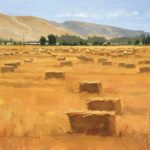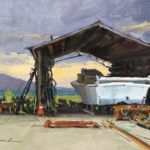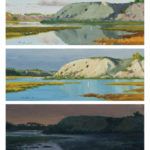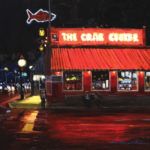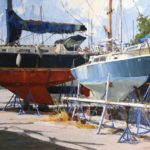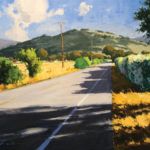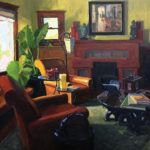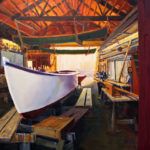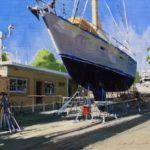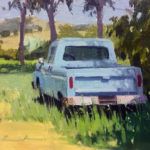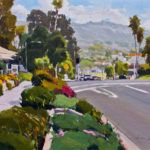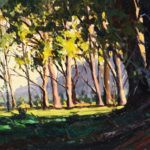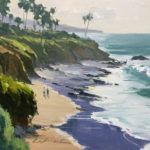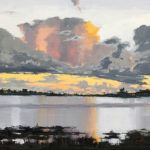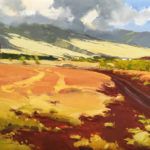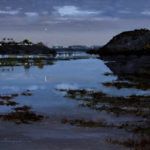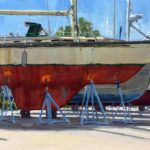For Greg LaRock, successful plein-air painting relies on capturing the most appealing shapes of the world
By Norman Kolpas
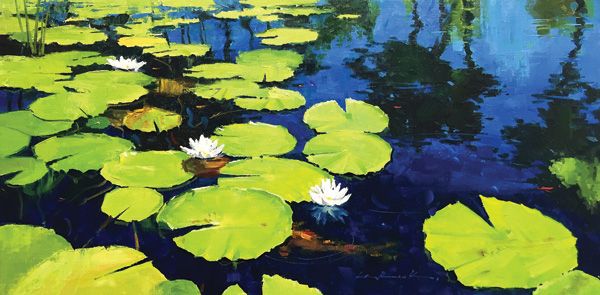
Greg LaRock, Limelight, oil, 15 x 30.
This story was featured in the September 2019 issue of Southwest Art magazine. Get the Southwest Art September 2019 print issue or digital download now–then subscribe to Southwest Art and never miss another story.
ONE SEPTEMBER morning back in 2017 at the Sonoma Plein Air Festival, Greg LaRock found his way to the Napa Valley Marina, a vintage private harbor on a northern inlet of San Francisco Bay less than half an hour away from California’s wine country. “I love old boatyards,” he says of the reason behind his excursion. “I love all the interesting forms and the way they fit together.” LaRock spent “a good hour” walking around the marina where, by his estimate, “more than 200 boats were stored. The place was just massive.” He spent much of that time staring through a viewfinder in search of the best compositional vantage point.
Finally he found a scene that appealed to him, with a trio of sailboats held aloft by spindly blue metal stands, and many more masts rising in the near and far distance. “I liked the nice angle of the smaller blue boat against the larger red-and-blue boat,” he says. So he set up his easel and drew the composition directly onto his 18-by-24-inch canvas. “It takes a while to get all the forms and proportions right,” he adds. Finally, LaRock called it a day.
- Greg LaRock, All Bundled Up, oil, 16 x 20.
- Greg LaRock, Bruised Skies, oil, 12 x 16.
- Greg LaRock, Ch-ch-ch Changes – Three Shades of the Bay, oil, 18 x 16.
The next morning, he was back at the marina again. This time, says the artist, “it took about three hours to block in the big color shapes.” He also decided to take the liberty of adding leafy green treetops in the upper corners of the painting. “There needed to be something in the sky other than just the masts, so I edited it to [look] how I wanted it,” he explains.
Finally, on the third morning, LaRock returned again. This time he devoted his attention to “all the detail work” such as the ropes, lines, and riggings, along with other subtleties like streaks of paint on the concrete deck and puffy clouds in the pale-blue sky. LaRock decided that JUXTAPOSITION, as he called the finished work, was the best painting he did during the Sonoma gathering, and he submitted it for judging by his peers. It was chosen to receive the Artists’ Choice Award.
That’s just one of many high-water marks during his relatively recent dedication to fine art, which the 54-year-old began pursuing just over 15 years ago following a successful career as a graphic designer. It might surprise viewers to know that LaRock chooses the subjects he paints—be they watercraft, a pastoral scene, an old industrial site, or a moonlit slough—not necessarily because of any inherent interest they may hold for him but purely for their graphic elements. “The subject is the least important thing. I’m always looking first for the abstract, the base design. Someone else may see that boat,” he says, “but for me it’s seeing the shapes, a collection of light and dark patterns that come together—and when I see that, I want to paint it.” And while some people might describe the results as impressionistic, LaRock resists labels. “Styles are for the critics, the historians, the gallery people,” he says.
- Greg LaRock, Cooking in the Dark, oil, 20 x 24.
- Greg LaRock, Juxtaposition, oil, 18 x 24.
- Greg LaRock, Run of the Mill, oil, 18 x 24.
CAPTURING THE shapes he sees around him has been an interest for LaRock stretching back to his childhood in Huntington Beach, a coastal community in Orange County, CA. “Drawing was just what I liked to do to pass the time,” he explains matter-of-factly. By the time he reached high school, his natural talent had come to the notice of his teachers, particularly Jerry Nicholson, known as “Mr. Nick” at Edison High School; he encouraged LaRock to enroll in art classes at nearby Orange Coast College during his senior year. LaRock was awarded the school’s gold medal for arts and was one of the winners in a local student competition through the Laguna College of Art and Design. That led him, in turn, to take summer art classes there, including his first instruction in live figure drawing.
After he spent a couple of years in community college, LaRock transferred to the well-respected art department at California State University, Long Beach, from which he graduated in 1988 with a degree focused on drawing and painting. “I was basically an average student,” he says of the other academic requirements he had to meet. “The only thing I excelled at was the arts, but I didn’t know where it was going to lead me.”
- Greg LaRock, Solitude, oil, 24 x 30.
- Greg LaRock, The Comfy Chair, oil, 36 x 48.
- Greg LaRock, Back Stage Lass, oil, 30 x 40.
Where his education soon led was to work as the designer of a local magazine. “I was a self-taught graphic artist,” he said of the detailed manual work he did during those years before the computer revolutionized design. When the magazine folded after a few years, LaRock set out on his own, tackling the graphic design of “whatever people needed done, working for a very wide range of clients” on anything from letterheads to brochures to product packaging, a line of work in which he continued for 18 years.
During that time, he reckons he made “less than a handful of paintings.” But, he says, as his work began to feel more and more like “you’re on cruise control,” he began to think about picking up a brush. To get started, he signed up for a life-drawing class at a nearby community college, telling the instructor, “Don’t pay any attention to me. I just want to sit in the back and draw.” He enjoyed it and signed up again for a second semester.
Then, one of the few other older students in the class told him about the Laguna Plein Air Painters Association, a well-respected local group that held live figure-drawing sessions several times a week. LaRock signed up. That led him, in turn, to attend his first-ever plein-air paint-out, a session on the beach taught by the late Laguna Beach artist Ken Auster. “I got to put my feet in the sand and paint the beach,” LaRock recalls. “My painting was a disaster, but it was an awesome experience.”
- Greg LaRock, Blue Angles, oil 12 x 16.
- Greg LaRock, Faded Blue, oil, 8 x 10.
- Greg LaRock, Highway Color, oil, 18 x 24.
He kept at it, going to more and more paint-outs. His work gradually improved, and in 2004 he sold his first three paintings, all plein-air landscapes. “Oh my god,” he remembers thinking to himself. “I wonder if this could turn into something if I took it seriously.” During 2005, he decided “to hit this hard and push myself,” and over the next few years he was accepted into more and more plein-air shows while he gradually tapered off his graphic-design practice, handing off his best clients to his wife and partner of 26 years, Laurie.
By 2008, LaRock says with a touch of self-deprecation, he was “on the map and an award-winning plein-air artist,” going on to participate regularly in invitational events from Maui to Sonoma and from Newport Beach to Maryland. “I really like going to different areas. Once you’ve painted everything around your hometown, it opens up all kinds of doors for excitement and new potential to see different subject matter, different qualities of light, different architecture, different lays of the land.”
He also began to share the wealth of knowledge and experience he’s gained by teaching his own plein-air painting workshops. “With the successes I’ve had,” he explains, “I thought it would be nice to turn things around. I feel so grateful for all the instruction I got, and I learn so much from explaining to other artists why I do the things that I do.”
- Greg LaRock, Light Through the Trees, oil, 12 x 24.
- Greg LaRock, Purple Shores, oil, 9 x 12.
- Greg LaRock, Reflecting Skies, oil, 12 x 24.
Empowered by those insights, LaRock doesn’t always have to travel far to come up with a great subject for a painting. By way of example, consider THE COMFY CHAIR. Walking through the living room of the 1922 Craftsman home he and Laurie bought just over two years ago in the town of Orange, he kept thinking to himself, “That’s a painting!” Finally, working in the studio he’s set up in his garage, he embarked on painting the scene. The finished work even includes a painting-within-a-painting hanging above the mantel—but it’s not a miniature reproduction of one of LaRock’s own works, as he’d originally attempted. “That felt so pretentious,” he admits. So he called fellow painter Anne Blair Brown, an impressionist based in Nashville, TN, and asked her permission to include a tiny homage to her work. “She was flattered and thrilled,” he says.
Executed in rich shades of brown, green, and deep purple, the completed painting is comfortably inviting. Yet, while admitting that allure, LaRock remains insistent that, for him, the shapes are the thing. “I’m always looking for a challenge, and the challenge here was all those indoor shapes that I’m less familiar with painting, and the way the early morning light comes in and does certain things,” he says of the visual challenges that attracted him. “It was fun to pull off.”
representation
Chemers Gallery, Tustin, CA; Forest & Ocean Gallery, Laguna Beach, CA; Huse Skelly Fine Art Gallery, Balboa Island, CA; www.greglarock.com.
- Greg LaRock, Roasted Reds, oil, 16 x 20.
- Greg LaRock, The Cool of the Night, oil, 12 x 20.
- Greg LaRock, The Usual Suspects, oil, 12 x 24.
This story was featured in the September 2019 issue of Southwest Art magazine. Get the Southwest Art September 2019 print issue or digital download now–then subscribe to Southwest Art and never miss another story.
MORE RESOURCES FOR ART COLLECTORS & ENTHUSIASTS
• Subscribe to Southwest Art magazine
• Learn how to paint & how to draw with downloads, books, videos & more from North Light Shop
• Sign up for your Southwest Art email newsletter & download a FREE ebook






